Input interpretation

2-ethoxyethanol
Chemical names and formulas

formula | C_2H_5OCH_2CH_2OH Hill formula | C_4H_10O_2 name | 2-ethoxyethanol alternate names | cellosolve | Cellosolve®ethyl glycol | ethanol, 2-ethoxy- | ethyl cellosolve | ethylene glycol monoethyl ether mass fractions | C (carbon) 53.3% | H (hydrogen) 11.2% | O (oxygen) 35.5%
Lewis structure
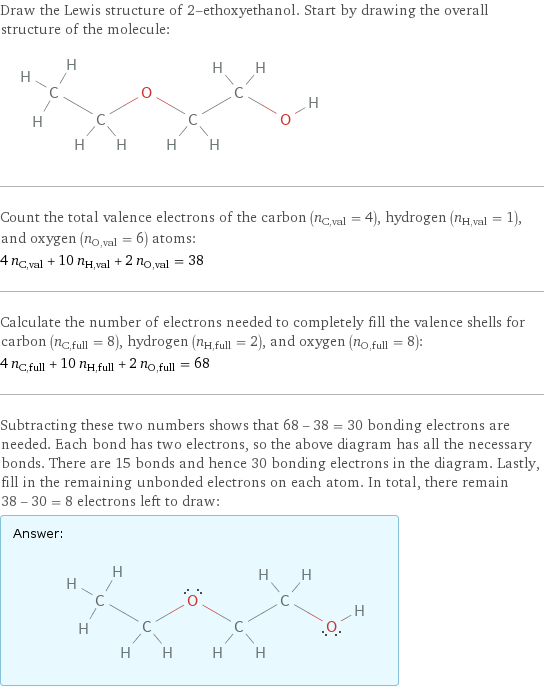
Draw the Lewis structure of 2-ethoxyethanol. Start by drawing the overall structure of the molecule: Count the total valence electrons of the carbon (n_C, val = 4), hydrogen (n_H, val = 1), and oxygen (n_O, val = 6) atoms: 4 n_C, val + 10 n_H, val + 2 n_O, val = 38 Calculate the number of electrons needed to completely fill the valence shells for carbon (n_C, full = 8), hydrogen (n_H, full = 2), and oxygen (n_O, full = 8): 4 n_C, full + 10 n_H, full + 2 n_O, full = 68 Subtracting these two numbers shows that 68 - 38 = 30 bonding electrons are needed. Each bond has two electrons, so the above diagram has all the necessary bonds. There are 15 bonds and hence 30 bonding electrons in the diagram. Lastly, fill in the remaining unbonded electrons on each atom. In total, there remain 38 - 30 = 8 electrons left to draw: Answer: | |
3D structure
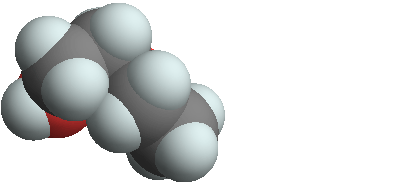
3D structure
Basic properties

molar mass | 90.12 g/mol phase | liquid (at STP) melting point | -90 °C boiling point | 135 °C density | 0.93 g/cm^3 solubility in water | miscible dielectric constant | 29.6
Hydrophobicity and permeability properties

experimental LogP hydrophobicity | -0.32 predicted LogP hydrophobicity | -0.27 predicted LogS | 0.81
Basic drug properties

approval status | experimental | small molecule
Liquid properties (at STP)

density | 0.93 g/cm^3 vapor pressure | 3.799 mmHg dynamic viscosity | 0.00214 Pa s (at 20 °C) surface tension | 0.0282 N/m refractive index | 1.407 UV cutoff wavelength | 210 nm
Units
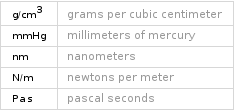
Thermodynamic properties

specific heat capacity c_p | liquid | 4.172 J/(g K) molar heat capacity c_p | liquid | 376 J/(mol K) molar heat of vaporization | 40.53 kJ/mol | specific heat of vaporization | 0.4497 kJ/g | molar heat of combustion | 2695 kJ/mol | specific heat of combustion | 29.9 kJ/g | critical temperature | 585 K | critical pressure | 4.41 MPa | (at STP)
Chemical identifiers

CAS number | 110-80-5 Beilstein number | 1098271 PubChem CID number | 8076 PubChem SID number | 24847824 SMILES identifier | CCOCCO InChI identifier | InChI=1/C4H10O2/c1-2-6-4-3-5/h5H, 2-4H2, 1H3 InChI key | ZNQVEEAIQZEUHB-UHFFFAOYAD RTECS number | KK8050000 MDL number | MFCD00002869
NFPA label

NFPA label
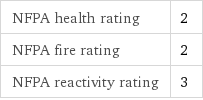
NFPA health rating | 2 NFPA fire rating | 2 NFPA reactivity rating | 3
Safety properties
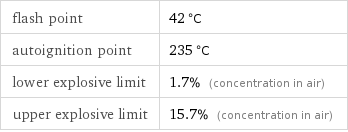
flash point | 42 °C autoignition point | 235 °C lower explosive limit | 1.7% (concentration in air) upper explosive limit | 15.7% (concentration in air)

DOT hazard class | 3 DOT numbers | 1171
Toxicity properties

odor | sweet | ether threshold limit value | 5 ppmv

long-term exposure limit | 37 mg/m^3 (over 8 hours) RTECS classes | tumorigen | mutagen | reproductive effector | primary irritant